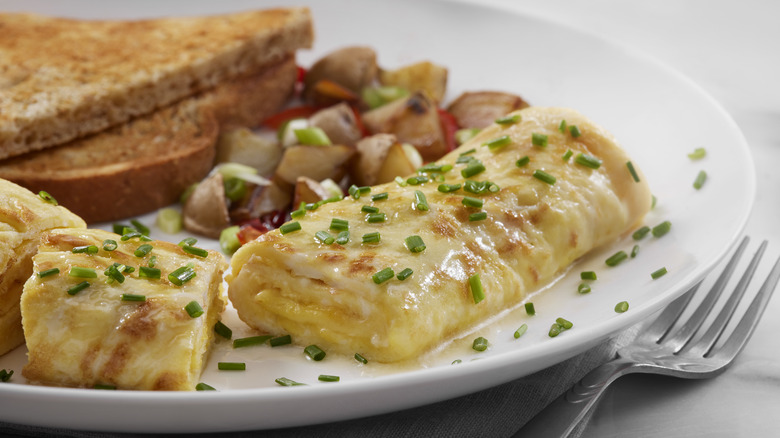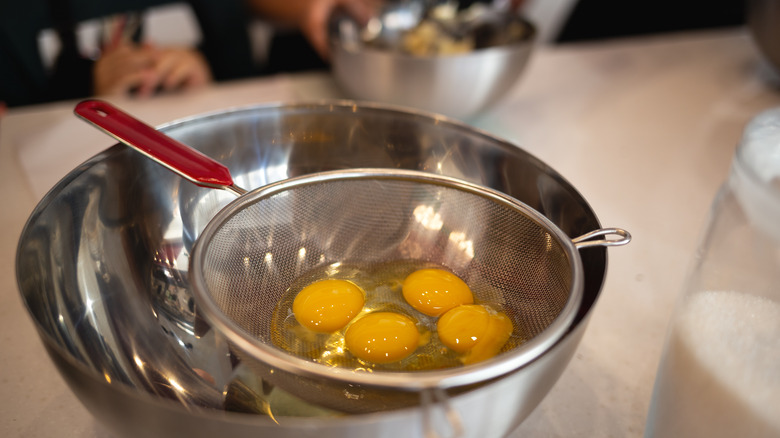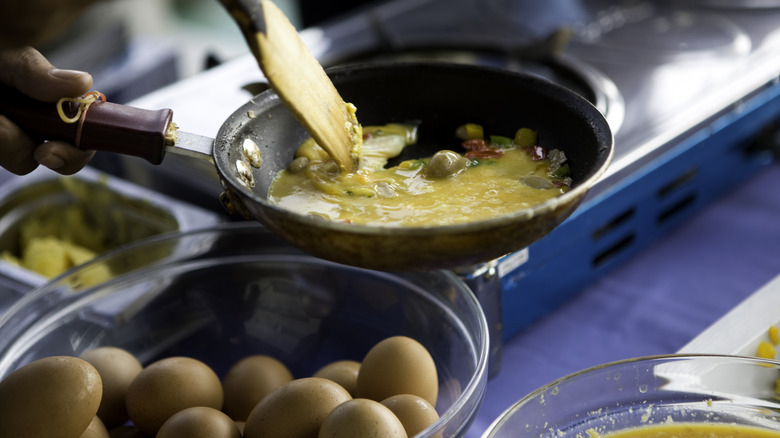How A Sieve Will Become Your Best Friend When Making An Omelet
A cornerstone of basic Western cuisine is the omelet, a dish on which aspiring chefs are regularly tested to gauge their technical skill and attention to detail. Much like scrambled eggs, the difference between an exceptional and mediocre one lies in a few simple steps, and while some of them can be chef secrets, one such trick that's been making the rounds is sieving the eggs before transferring them onto the pan.
You may have seen a sieved scramble in the second season of the restaurant-themed drama series, "The Bear" or come across it whilst scouring the internet for culinary inspiration. What's important to know is that the hack works! Straining eggs before cooking them results in a smoother texture and more uniformly mixed yolks and whites without having to over-whisk the eggs (which gets too much air into them). The trick works exceptionally well for French omelets but also helps give better and more consistent American-style omelets and scrambled eggs.
So, is it worth the extra step and trouble of soiling an additional utensil? Perhaps not every time, but when you want a great omelet and don't want to leave things to chance, a sieve can become your best friend.
The sieve benefits omelet making in multiple ways
Straining eggs through a sieve benefits the finished dish in multiple ways. The yolk and albumen are better homogenized, which results in more uniform cooking. Visually, your omelet will have an even yellow color instead of white streaks. In terms of texture, better homogeneity gives you more control over the consistency you want the inside of your omelets to have — cooked through and solidified or custardy and moist. The latter is characteristic of French omelets, which have small, delicate egg curds on the inside.
Sieving also helps eliminate stray eggshell fragments and the tough protein strings called chalazae, which can taint even the best-made omelets. Perhaps most importantly, sieving the eggs helps you get a more consistent result. It's one of those steps that can allow you to focus on and experiment with other aspects of making the iconic egg dish.
And if your endgame here is to replicate the delectable French omelet from "The Bear," it's worth knowing that while the sieve contributes significantly, the one produced in the Hulu drama series also benefited from a piped herbed cheese filling, a sprinkled topping of chives and crushed potato chips, as well as a few generous nobs of butter.
How to sieve eggs and everywhere you can use them
When straining eggs, you can either crack them straight into the sieve or lightly whisk them in a bowl, and then strain. Either way, use a fork to work the eggs through the mesh. This can be a bit of a time-consuming process, and pushing the eggs through the sieve requires some wristwork. If the eggs go through too quickly, it's good to use something with tighter webbing, however, go too fine and the sieve will be practically impassable for your scramble.
Because of the added step, those who generally pre-heat their pan while they prep their eggs may want to rethink their process. In the time it takes to sieve the eggs, the skillet could get too hot and even burn the butter. Instead, begin working the eggs through the sieve first, and once you know how long it takes, turn the heat on.
In addition to omelets, the sieve can help you make perfect, fluffy scrambled eggs with evenly cooked, delicate curds. The sieve is an essential ally in dishes like custard that require exceptionally smooth egg mixtures. Poached eggs also benefit from the sieve but for the opposite reason. Instead of passing the eggs through the mesh, it helps to separate the watery parts of the albumen, leaving you with a firm raw egg that's ideal for perfect poaching.


